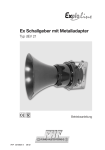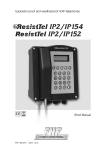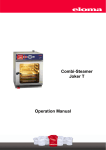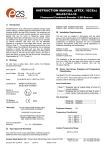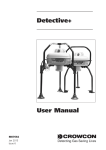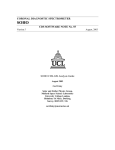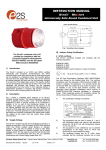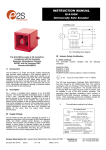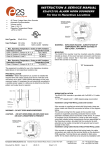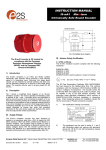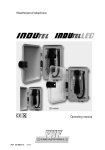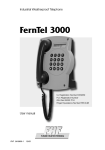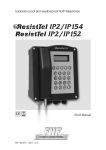Download Ex Sounder - bei FHF, Funke Huster Fernsig GmbH
Transcript
Ex Sounder Typ dEV 21 Operating instructions FHF BA 6924 08/12 Note Please read this manual carefully before installing the sounder. Application The Ex Sounder dEV 21 is a signalling device that generates various signalling tones and signalling tone sequences and emits them at a high sound pressure level. The user may choose between 31 preset signalling tone groups and one programmable one. Every signalling tone group contains 4 different signalling tones. Wire the control inputs with floating contacts or jumpers in order to chose any one of these 4 signalling tones. The sounder has 8 volume levels. All outer fastening parts are made of non-corrosive materials. The stable, all-plastic housing conforms to protection degree IP 66, which means the sounder can be installed both indoors and outdoors. Explosion category II 2 G Ex d e mb IIC T6 Gb allows the sounder to be operated in hazardous areas of zones 1 and 2. Setting the volume and the signalling tone groups prior to mounting the sounder The sounder ships with the following setting: Sound pressure: Signalling tone group: maximum Group0: continuous tone 1000 Hz; sweeping tone 1200 Hz / 500 Hz; intermittent tone 1000 Hz Selected signalling tone: continuous tone 1000 Hz If you want other signalling tones and volume levels, please follow the instructions below. To set the sound pressure level and the signalling tone groups, open the sounder housing. To do this you have to place the sounder on a level surface, the loudspeaker opening facing upwards. Loosen the 8 housing screws and lift the upper part of the housing slightly. Detach the connecting cable running from the loudspeaker to the circuit board at the circuit board and put the loudspeaker part aside. In the bottom part of the housing, on the circuit board, you will find the controls and an LED that are required to set the signalling tone groups. 2 plug connector loudspeaker L t h jumper field X1 = LS X1 LED H1 internal plug connector rotary switch S2 = 0 rotary switch S1 = 7 H1 S1 S2 F0 1 F0 1 2 2 DE DE 3 3 C C 4 4 B B A9 65 A9 65 8 7 87 Vol./Prog. Group/Tone Select Select 0..F LS: 0.. F US: 10..1F S3 Lower/Upper Select LS: 0.. F US: 10..1F Enter push button S3 Controls: Rotary switch S1: Vol./Prog. Select 0..F Settings: 0-7 Sound pressure level setting for normal operation. The 0 setting results in normal operation with the lowest possible volume, whereas the 7 setting results in normal operation with the highest possible volume. 8-B Programming the signalling tone group GroupF. The device is forced to go mute and LED H1 is switched on. Reserved, do not set! The device is forced to go mute. C-F Note: Setting the reserved positions C-F may alter the programming of the signalling tone group GroupF. Rotary switch S2: Group/Tone Select LS: 0..F US: 10..1F Settings: 0-F Selecting the signalling group Group0.. GroupF, when the jumper for LS has been set, or 0-F Selecting the signalling group Group10.. Group1F, when the jumper for US has been set, 3 Jumper field X1: Lower/Upper Select LS: 0..F US: 10..1F Settings: Jumper LS: Signalling tone group Group0...GroupF is selected using rotary switch S2. Jumper US: Signalling tone group Group10...Group1F is selected using rotary switch S2. Notes: If a jumper is lacking the setting LS is active. Set the jumpers in the marked positions LS or US of the jumper field only. Setting the jumpers in any other position might reduce the functionality of the device. Push button S3 Enter Key for programming the signalling tone group GroupF. LED H1 Programming assistance LED Procedure for setting the sound pressure level The programming procedure described below must be performed outside of hazardous areas only, because the opened device has to be supplied with voltage during the procedure. Turn the rotary switch S1 (Vol./Prog. Select 0..F) to a position between 0 and 7. Position 7 represents the maximum sound pressure level. For each of the positions 6 through 0 the sound pressure level is reduced by 3 dB(A). Procedure for setting a signalling tone group The active signalling tone group determines the 4 signalling tones that may be selected from the control inputs during operation. Setting the active signalling tone group a.) From the table „Signalling tone groups“, select the group to which the 4 signalling tones belong that you want to select by connecting the control inputs during operation. b.) If the selected signalling tone group belongs to one of the groups Group0 to GroupF, place the jumper in jumper field X1 in position LS. Otherwise, place the jumper in position US. Turn the rotary switch S2 (Group/Tone Select LS:0..F US: 10..1F) to the position corresponding to the last character of the line name of the selected signalling tone group. For instance to position A for the selected signalling tone group GroupA or to position 5 for the selected signalling tone group Group15. For the signalling tone group GroupF, the composition of the 4 signalling tones is freely programmable. Any one of the signalling tones Tone0 to Tone1F from the table “Signalling tone description” may be freely assigned to the settings Stage 0, Stage 1, Stage 2 and Stage 3. This programming procedure is described in greater detail below. 4 Signalling tone group GroupF programming procedure Any one of the signalling tones from the table “Signalling tone description” may be freely assigned to the settings Stage 0, Stage 1, Stage 2 and Stage 3 of the signalling tone group GroupF, in order to compose exactly the 4 signalling tones in signalling tone group GroupF that are required for a certain application. Programming the signalling tone group GroupF a.) First, turn the rotary switch S1 (Vol./Prog. Select 0..F) to one of the positions 8, 9, A or B, in order to force the device into the “mute” setting when the mains supply is switched on. b.) Turn on the mains supply of the device. The device goes mute and LED H1 is switched on. c.) In order to change a particular signalling tone, use the rotary switch S1 (Vol./Prog. Select 0..F) to select the corresponding setting among the Stage 0, Stage 1, Stage 2 or Stage 3 settings of signalling tone group GroupF. Do this by turning the rotary switch S1 to position 8 (Stage 0), 9 (Stage 1), A (Stage 2) or B (Stage 3). d.) Select the desired new signalling tone from the table “Signalling tone description”. e.) If the selected signalling tone belongs to the tone interval Tone0 to ToneF, place the jumper in jumper field X1 in position LS. Otherwise, place the jumper in position US. Turn the rotary switch S2 (Group/Tone Select LS:0..F US: 10..1F) to the position corresponding to the last character of the line name of the selected signalling tone. For instance to position A for the selected signalling tone ToneA or to position 5 for the selected signalling tone Tone15. f.) Press push button S3 (Enter) to trigger the programming procedure. LED H1 will be turned off during programming, and then on again after the programming is completed. Repeat steps c.) to f.) for all the settings of those tones of signalling tone group GroupF that you want to change. g.) Turn off the mains supply of the device. h.) Turn rotary switch S1 (Vol./Prog. Select 0..F) back to the preferred volume setting between position 0 and 7, place the jumper in jumper field X1 in position LS, and turn rotary switch S2 (Group/Tone Select LS:0..F US: 10..1F) to position F. Pick up the loudspeaker part of the housing again, connect the loudspeaker cable with the circuit board in the lower part and place the loudspeaker part on top of the lower part. Connect the housing parts with each other using the 8 housing screws. (Torque 3 Nm ± 0.3 Nm) 5 Setting the volume and the signalling tone groups following sounder mounting If the signalling tone and sound pressure level settings must be changed after the device has been mounted, the sounder must be dead (no-voltage). Wait more than 15 minutes before opening the device. Loosen the 8 housing screws and lift the upper part of the housing slightly. Detach the connecting cable running from the loudspeaker to the circuit board at the circuit board and put the loudspeaker part aside. Perform the setting as described above. Warning: The programming of signalling tone group GroupF must be performed outside of hazardous areas only, because the opened device has to be supplied with voltage during the procedure. 6 Table: Signalling tone groups Stage 0..Stage 3 represent the signalling tones selected via the connections of the control inputs. 4 5 3-----4 Stage 2 5 3 4-----5 Stage 3 3-----4-----5 Group0 Mute Tone0 Tone1E Group1 Mute Tone1 ToneB Tone13 Group2 Mute Tone2 Tone1 Tone13 Group3 Mute Tone3 Tone4 Tone13 Group4 Mute Tone4 Tone5 Tone13 Group5 Mute Tone5 Tone8 Tone13 Group6 Mute Tone6 Tone1 Tone13 Group7 Mute Tone7 Tone12 Tone1 Group8 Mute Tone8 Tone5 Tone13 Group9 Mute Tone9 Tone1E Tone0 GroupA Mute ToneA Tone3 Tone13 Tone9 GroupB Mute ToneB Tone1 Tone1A GroupC Mute ToneC Tone1 Tone13 GroupD Mute ToneD ToneE Tone13 GroupE Mute ToneE Tone1 GroupF Mute Group10 Mute Tone10 Tone12 Tone13 Group11 Mute Tone11 Tone3 Tone13 Group12 Mute Tone12 Tone1 Tone13 Group13 Mute Tone13 Tone2 Tone1A Group14 Mute Tone14 Tone1 Tone13 Group15 Mute Tone15 Tone1 Tone13 Group16 Mute Tone16 Tone4 Tone13 Group17 Mute Tone17 Tone1C Tone13 Group18 Mute Tone18 Tone1C Tone13 Group19 Mute Tone19 Tone1 Tone0 Group1A Mute Tone1A Tone19 Tone13 2) S1 = 8 ToneF 2) S1 = 9 Tone1 Tone13 2) S1 = A Tone13 Group1B Mute Tone1B Tone1 Tone13 Group1C Mute Tone1C Tone5 Tone13 Group1D Mute Tone1D Tone1F Tone13 Group1E Mute Tone1E Tone9 Tone0 Group1F Mute Tone1F Tone19 Tone0 1) 1) Jumper in position LS of jumper field X1 3 Stage 1 2) S1 = B Jumper in position US of jumper field X1 Stage 0 Corresponding connections for input terminals 3, 4 and 5. 2) The signalling tone group GroupF ships in the following state. The assignment of the signalling tones may be changed by programming. The entry S1 = x identifies the required position of the rotary switch S1 (see „ Signalling tone group GroupF programming procedure “). 7 Table: Signalling tone description Tone0 Tone1 Tone2 1000Hz 800/1000Hz@ 0.25s 500/1200Hz@ 0.3Hz 0.5s Tone3 Tone4 Tone5 Tone6 Tone7 800/1000Hz@ 1Hz 2400/2900@ 7Hz 2400/2900@ 1Hz 500/1200Hz@ 0.3Hz 1200/500Hz@ 1Hz Tone8 Tone9 ToneA ToneB ToneC ToneD ToneE ToneF 2400/2900@ 2Hz 1000Hz@ 1Hz 800/1000Hz@ 0.875Hz 544Hz(100ms)/440Hz(400 ms) 1400Hz(1s)/1600Hz(0.5s) 660Hz@ 3.33Hz 660Hz/(1.8s),1.8s off 660Hz Continuous PFEER Toxic Gas Alternating Slow Whoop Sweeping Sweeping Sweeping Sweeping Sweeping DIN / PFEER P.T.A.P. Alternating Intermittent Alternating Alternating NF S-32-001 Tone10 Tone11 Tone12 Tone13 Tone14 Tone15 Tone16 Tone17 Tone18 Tone19 Tone1A Tone1B Tone1C Tone1D Tone1E 2400Hz@ 1Hz 800Hz(0.25s), 1s off 800Hz 2400Hz 554/440Hz@ 1Hz 544Hz@ 0.875Hz 800Hz@ 2Hz 800/1000Hz@ 50Hz 2400/2900Hz@ 50Hz Mute 554Hz 440Hz 800/1000Hz@ 7Hz 420Hz 1.6Hz 1200/500Hz@ 1Hz Tone1F 500/1200Hz@ 3.75s 0.25s 8 Standard Sy Timing nc diagram a a a a a a a a a Sweeping NFC48-265 Intermittent Intermittent Continuous a Intermittent Intermittent Continuous Continuous Alternating Intermittent Intermittent Sweeping Sweeping a a Continuous Continuous Sweeping Intermittent Australian Alert Sweeping DIN / PFEER P.T.A.P. Slow Australian Evac. Whoop Jumper in position LS of jumper field X1 Type a a a a a a a Jumper in position US of jumper field X1 Parameter Possible applications Single sounder with a fixed signalling tone: You have selected a signalling tone group according to the procedure described earlier in this manual. To select a fixed signalling tone (Stage 0, Stage 1, Stage 2 or Stage 3) from the signalling tone group, the control inputs must be connected accordingly. The control inputs are the terminals 3, 4 and 5, located in the sounder’s electrical enclosure. Place the sounder with the horn opening resting on a level surface, loosen the 6 screws of the electrical enclosure lid and remove the lid. Perform the setting of a fixed signalling tone as follows: Stage 0 No connections Stage 1 Stage 2 Connect terminal 3 and terminal 4 using a jumper Connect terminal 4 and terminal 5 using a jumper Stage 3 Connect terminals 3, 4 and 5 using a jumper. Single sounder with variable signalling tone: If there is a requirement for the ability to select the individual signalling tones of a signalling tone group (Stage 0, Stage 1, Stage 2 or Stage 3) during operation, terminals 3, 4 and 5 must be connected accordingly to the floating contacts of a control device. This may be prepared at this stage, or after the sounder has been mounted. Select a signalling tone via floating contacts k1 and k2 as follows: Stage 0 Both contacts open Stage 1 Contact k1 closed, contact k2 open Stage 2 Contact k1 open, contact k2 closed Stage 3 Both contacts closed 9 Multi-sounder with a fixed signalling tone: If several sounders are being operated simultaneously with the same signalling tone, it may be a good idea to synchronise the signalling tones, i.e. to make sure the signalling tones of all the sounders sound for an equally long period of time. This is only possible with the signalling tones for which “Sync” has been ticked off in the table “Signalling tone description”. To enable synchronisation, the terminals 3 of all the sounders, the terminals 4 of all the sounders and the terminals 5 of all the sounders must be interconnected. To select a fixed signalling tone (Stage 0, Stage 1, Stage 2 or Stage 3) from the set signalling tone group, the control inputs of one of the sounders must be connected accordingly. This may be prepared at this stage, or after the sounder has been mounted. Perform the setting of a fixed signalling tone as follows: Stage 0 No connections Stage 1 Stage 2 Connect terminal 3 and terminal 4 using a jumper Connect terminal 4 and terminal 5 using a jumper Stage 3 Not a useful setting in this application, as synchronisation is not possible when terminals 3, 4 and 5 are interconnected. Multi-sounder with variable signalling tone: As „Multi-sounder with a fixed signalling tone“, except that the signalling tone may be chosen via floating contacts of a control device. Select a signalling tone via floating contacts k1 and k2 as follows: Stage 0 Both contacts open Stage 1 Stage 2 Contact k1 closed, contact k2 open Contact k1 open, contact k2 closed Stage 3 Both contacts closed. Please note that for this selection a synchronisation of the signalling tones is not possible. 10 Mounting The sounder is suited for wall and ceiling mounting. For mounting dimensions, see the dimension illustration (on page 12). The wall bracket included in the box is fastened with 2 screws (∅ 6 or 8 mm). To connect, loosen the 6 lid screws and remove the lid. The fasteners and the mounting surface must be able to safely carry the weight of the sounder. Installation Prior to leading the connecting sounder cables through the cable gland, 100 – 130 mm of the isolation must be removed. Before connecting the single connectors to the terminals, remove 8 to 10 mm of isolation from the connectors. Terminal Version 85 - 265VAC Version 21.6 - 75VDC 1, 1 N L+ / L2, 2 L1 L- / L+ 3 4 5 After connecting the loudspeaker, place the single conductors of the connecting cables flatly across the connecting terminals, in the direction of the cable gland. Use only suited tools for installing the cable glands. The cable connection is suited only for permanent cables. Warning! To avoid the connectors getting pinched, do not place them over the sealing edge. Use sufficiently long cables to facilitate positioning of the sounders at a later stage. Close the lid Prior to closing the lid, the sealing surfaces and the sealing must be checked for damage and dirt, and cleaned if necessary. Damaged seals must be replaced by original seals from the manufacturer. Put the lid on. Make sure the lid sits straight, and that the „lid fastener“ has not been placed across the threaded lid bolt or across the sealing edge. Then turn the lid screw as far as it goes, and tighten lightly. Positioning the sounder Swing the sounder in the desired position and tighten both side screws on the wall bracket. Operating position In order to avoid a reduction of the volume due to dust, rainwater or other foreign matter, the horn should be mounted horizontally or facing downwards. Care and maintenance The sounder is maintenance-free. In very dusty or dirty surroundings, the sounder should nevertheless be cleaned with a damp cloth from time to time. Never use sharp objects for cleaning. Special operating conditions In order to maintain the given listening quality, the sounder must not be mounted in close vicinity of sources of magnetic fields with technically relevant frequencies. 11 Disposal The device may be recycled as electronic waste. When the device is disassembled, plastics, metals and electronics are to be disposed of separately. In every single case the national requirements and regulations for waste disposal must be observed. User Information This is a flameproof device designed for operation in explosive atmospheres. As a group II, category 2 device it is designed for use in Zone 1 and 2. Please note the following warnings and security information: 1. The installation and adjustment of the device must be carried out by qualified personnel in accordance with the prescribed installation regulations taking the specified explosion category into account. Repairs only may be carried out by the manufacturer or by a person appointed by the manufacturer followed by a renewed product conformity inspection. 2. This device corresponds to insulation class II according to EN 60335-1 3. If the device is damaged, it may not be operated. 4. While operating the device in business or industry facilities, the legally or otherwise required precautions against accidents resulting from the use of electrical systems and devices must be taken. 5. The equipment may only be operated under the prescribed ambient conditions. Unfavourable ambient conditions not covered by the explosion category of the device can lead to damage of the device and thus present a potential danger to the user’s life. 6. During operation of the device the temperature must not exceed nor fall below the prescribed range of ambient temperatures. It is not allowed to operate the device with an additional cover. Avoid heat accumulation on the site! 7. Please pay attention to the required operating position of the device. 8. Only blind plugs and cable glands as prescribed by the manufacturer may be used. 9. The sounder must be dead (no-voltage) before opening. Wait at least 15 minutes after switching off the power before opening the device! 10. The device may only be cleaned using a damp cloth in order to avoid electrostatic charging. Should these points not be observed, the explosion protection of the device cannot be guaranteed. The device is then a potential source of danger to life of the user and can cause the ignition of an explosive atmosphere. 12 13 278 mm Dimensions 365 mm Technical Data Type: dEV21 Testing and certification: Explosion category: EC type examination certificate Housing degree of protection: Insulation class Time to wait before opening the device after turning off operating power II 2 G Ex d e mb IIC T6 Gb CE 0158 PTB 03 ATEX 1121 IP 66 IEC 60529 II ≥ 15 minutes Housing: Housing material Metal components Dimensions Weight Plastic Stainless steel V4A (ASTM 316) ~ ∅ 278 x 365 mm ~ 5.9 kg Electrical connections: Mains connection (terminals 1 - 2) - Operating voltage UB - Operating frequency - Power consumption P (Tone1B, Max. sound pressure) - Power consumption (mute) - Power factor cos(ϕ) Control inputs (terminals 3 - 4 / 4 - 5) - Open circuit voltage UO - Short circuit current IO - Number of sounders connected in parallel - Wiring length DC-version L+, L21.6 – 75 VDC --≤ 12.5 W 1) ≤ 2,5 W 0.5 – 0,7 2) ≤ 2.5 W --- all versions ≤ 5.5 V ≤ 0.6 mA ≤ 32 ≤ 3000 m Minimum cross-section 0.75 mm2 1) Power consumption is, to a great extent, independent of the operating voltage. It does, however, depend on the signalling tone and the sound pressure level. The given value specifies the highest power consumption of the device. 2) The power factor of the alternating current version depends on the operating voltage. The following formula determines the operating voltage dependent operating current IB of the device. IB ≈ P UB ∗ 0,794 − 1,11∗ 10 −3 ∗ UB ( Cable diameter 14 AC-version L1, N 85 – 265 VAC 50 – 60 Hz ≤ 12.5 W 1) ) For the DC version the following is valid: IB = P / UB Ø 5.5 to 13.0 mm Connecting terminals: Clamping capacity, single wired, fine-wired or multi-wired Multiconductor connection 3) ≤ 2.5 mm (AWG 14) 2 maximum 2 x 1 mm 2 3) Multiconductor connection is allowed at same cross-section and same conductor type, up to the given value. In case of multi-wired conductors, wire-end sleeves are required. Pay attention to EN 50019! Acoustic data: Signal tones Sound pressure Angle, -6 dB at 1000 Hz Operating conditions: Mounting site Operating mode Operating position Ambient temperatures: Operating Transport Storage 31 tones ≤ 119 dB(A) at 1 m distance ≤ 130° Indoors and outdoors 100% continuous operation any, although preferably such that the horn is protected from intrusion of dust, rain water and other pollution. -20°C to +40°C -25°C to +70°C -25°C to +70°C EMC-Directive The device complies with the requirements of the new EMC-directive 2004/108/EC and the low voltage directive 2006/95/EC. The conformity with the above directives is confirmed by the CE sign. 15 Subject to alterations or errors FHF Funke + Huster Fernsig GmbH Gewerbeallee 15-19 · D-45478 Mülheim an der Ruhr Phone +49 / 208 / 82 68-0 · Fax +49 / 208 / 82 68-286 http://www.fhf.de · e-mail: [email protected]
















